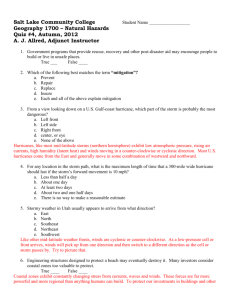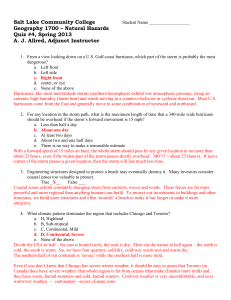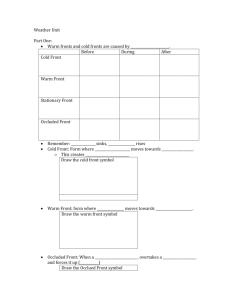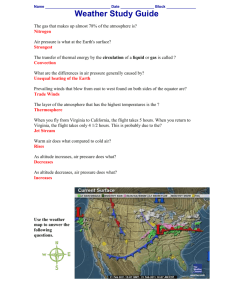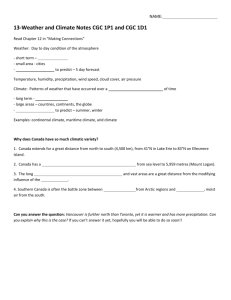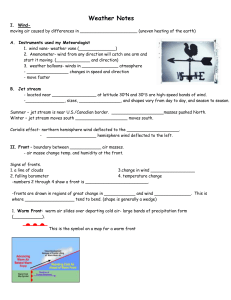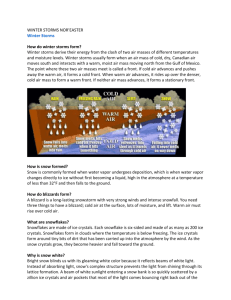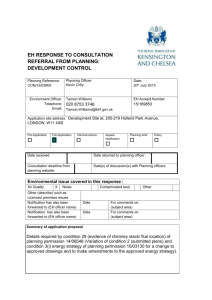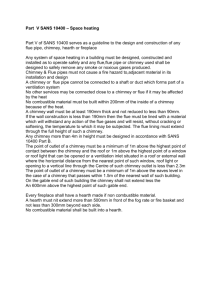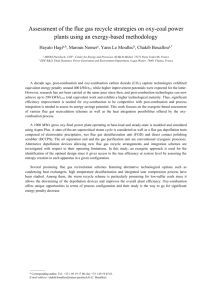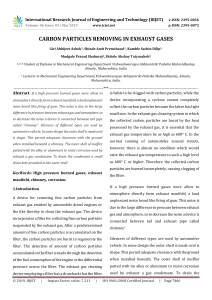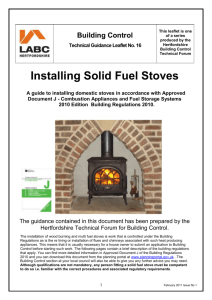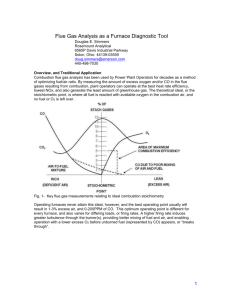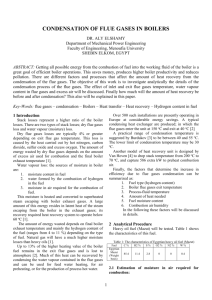Salt Lake Community College
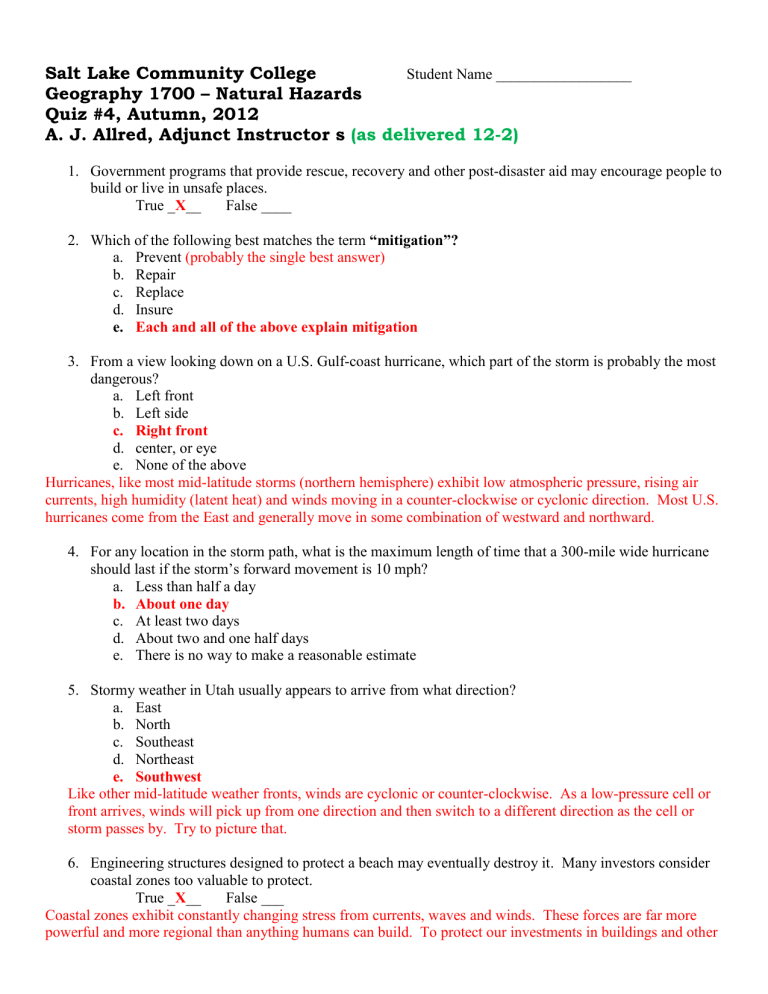
Salt Lake Community College
Geography 1700 – Natural Hazards
Quiz #4, Autumn, 2012
A. J. Allred, Adjunct Instructor s (as delivered 12-2)
Student Name __________________
1.
Government programs that provide rescue, recovery and other post-disaster aid may encourage people to build or live in unsafe places.
True _ X __ False ____
2.
Which of the following best matches the term
“mitigation”?
a.
Prevent (probably the single best answer) b.
Repair c.
Replace d.
Insure e.
Each and all of the above explain mitigation
3.
From a view looking down on a U.S. Gulf-coast hurricane, which part of the storm is probably the most dangerous? a.
Left front b.
Left side c.
Right front d.
center, or eye e.
None of the above
Hurricanes, like most mid-latitude storms (northern hemisphere) exhibit low atmospheric pressure, rising air currents, high humidity (latent heat) and winds moving in a counter-clockwise or cyclonic direction. Most U.S. hurricanes come from the East and generally move in some combination of westward and northward.
4.
For any location in the storm path, what is the maximum length of time that a 300-mile wide hurricane should last if the storm’s forward movement is 10 mph? a.
Less than half a day b.
About one day c.
At least two days d.
About two and one half days e.
There is no way to make a reasonable estimate
5.
Stormy weather in Utah usually appears to arrive from what direction? a.
East b.
North c.
Southeast d.
Northeast e.
Southwest
Like other mid-latitude weather fronts, winds are cyclonic or counter-clockwise. As a low-pressure cell or front arrives, winds will pick up from one direction and then switch to a different direction as the cell or storm passes by. Try to picture that.
6.
Engineering structures designed to protect a beach may eventually destroy it. Many investors consider coastal zones too valuable to protect.
True _ X __ False ___
Coastal zones exhibit constantly changing stress from currents, waves and winds. These forces are far more powerful and more regional than anything humans can build. To protect our investments in buildings and other
structures, we build more structures and often ‘nourish’ a beach to make it last longer or make it more attractive.
7.
What climate pattern dominates the region that includes Chicago and Toronto? a.
H, Highland b.
B, Sub-tropical c.
C, Continental, Mild d.
D, Continental, Severe e.
None of the above
Divide the USA in half – the east is humid (wet), the west is dry. Then cut the nation in half again – the north is cold, the south is warm. So, we have four quarters: cold/dry, cold/wet, warm/wet and warm/dry.
The northern half of our continent is ‘severe’ while the southern half is more mild.
8.
What two climate zones prevail in Utah? a.
A and B only b.
B and C only c.
C and D d.
B and H, with some D e.
E and A, with no H
A handy way to summarize climates:
A = Tropical. Near the Equator – sunny, warm, rainy, lush vegetation.
The tropics are directly under the rising-air end of Hadley cells. The ITCZ hovers close by.
B = Dry - the zones directly above and below the Equator, at about 30 degrees north and south of the
Equator. Usually desert, these regions are directly underneath the high-pressure end of
Hadley cells)
C = Mild Continental. Relatively easier or more comfortable climate, not high latitude, not far from ocean, not high elevation, not too dry, not too wet, not too cold, not too hot.
D = Severe Continental. Larger annual swings in temperature, higher latitudes, associated with
big continental land masses, often higher elevation, and/or far from prevailing on-shore ocean breezes.
E = Polar. Very high latitude.
H = Highland. Mountains have a climate all their own. Wide swings in temperature and precipitation, even daily.
9.
In the United States, millions of people are moving to locations that are prone to deadly hurricanes.
True __ X __ False ____
10.
Nearly all ocean waves are wind-driven, which mean that water oscillates back and forth without really going anywhere.
True _ X ___ False ____
11.
For people, governments and businesses, the most practical approach to natural hazards is to: a.
Just move somewhere that has no hazards b.
Take out insurance policies to prevent loss of life and property damage c.
Promote and follow the best mitigation strategies that you can afford d.
Promote government programs that provide disaster warnings and rescue services e.
All of the above are equally practical
12.
The fact that never before in the history of the Earth have we had a billion automobiles, a billion cows and 100,000 power plants probably means that humans have no effect on the Earth’s atmosphere.
True ____ False _ X ___
Does the teacher sound a little sarcastic on this one? People around us all have an opinion as well. The theory of “anthropomorphic climate change” is a theory, but is backed by evidence that many scientists consider overwhelmingly conclusive -- that humans are now a factor in ‘climate forcing’ or induced change.
13.
“Global warming” could mean that some of the Earth’s glaciers and ice sheets could be adding volume or moving faster.
True _ X ___ False ____
Consider that warm air can hold more moisture than cold air, and precipitation (including snow) requires latent heat. Consider also that the weather forecast often calls for the “warm before the storm.” How might those factors affect the size or movement of ice sheets and glaciers? Could climate change include more than just hotter weather and shorter winters? See page 430 in the textbook, first column, last paragraph.
14.
During an “El Nino” event, waters of the eastern Pacific Ocean do not move westward as much as normal. An easy way to describe the result is that some drier places on Earth receive much more precipitation than usual, while many wetter places experience relative drought. Overall, an El Nino condition may tend to result in more atmospheric energy available for vigorous storms.
True _ X ___ False ____
15.
In general, average sea level varies directly with global air temperature.
True __ X __ False ____
Substances that are warmer experience more molecular movement or agitation, so they expand in volume per unit weight. Less density means more volume, even for water as a liquid.
Meanwhile, increasing air temperature tends to result in more evaporation, more precipitation and the melting of ice. Conversion of white ice to dark water ought to result in more absorption of solar energy and therefore rising water temperature over time.
On one hand, floating ice that melts will become more dense; however, if land ice melts it will go into the ocean, adding much more volume than was lost when floating ice contracted in volume.
16.
Fighting fires at night may be easier than during the day because relative humidity goes down during the daytime.
True _ X ___ False ____
17.
A massive volcano and/or a major meteorite striking Earth will tend to warm the Earth a bit by bringing more heat into the atmosphere for a few years, resulting in disturbed farming and short-term risk of starvation.
True ____ False _ X ___
18.
Overall, wildfires are probably good for the natural environment, including plant and animal populations in the burn area.
True _ X ___ False ____
Chapter 13 provides a wide variety of evidence of the pros and cons of wildfire effects on plants and animals.
Can you find the overall, generalized conclusion?
19.
There is generally a positive correlation between wildfires and mass wasting (such as landslides).
True __ X __ False ____
20.
A rip current tends to pull steadily at the same location, providing an opportunity for beach warning signs to be posted in areas where adequate public program support has developed over time.
False __ X __ True ____
Essay Extra Credit: Last week, a Sugarhouse family was injured by carbon monoxide poisoning at home.
Meanwhile, the weather report indicated that prevailing high pressure conditions in Salt Lake valley caused surface evaporation to stay near the ground. What relationship could be drawn between these facts?
____________________________________________________________________________________
Sample Answer:
High pressure atmosphere tends to involve either a “thermal” high or a “dynamic high”: thermal, or temperature high pressure is typically due to colder air, which is more dense. A dynamic, or windy high pressure, usually involves air that has been descending, or at least moving from higher pressure to lower pressure. A thermal high pressure condition also typically involves stale or stagnant air. As such, exhaust gases from a furnace may not be able to escape the chimney or flue if higher pressure air is above them in the pipe. Stagnant or still air also does not provide a ‘wick’ or ‘drafty’ condition that would help ‘pull’ exhaust gases up the chimney or flue pipe. To these factors can be added the weather report that humidity at the ground level was not rising as it normally would – humid air is less dense than surrounding dry air. Taken together, these factors suggest that poisonous exhaust gases would be less likely to leave the house than otherwise. This may be especially true during weather cold enough to take the heat out of slow-moving flue gases. As they cool down in the chimney or flue pipe, they lose buoyancy, further retarding their ability to resist the downward pressure of heavier outside that is coming down the pipe. A final note: during cold weather it is also more likely that building occupants would be using relatively more hot water, or furnace heat. As such, more exhaust gases might do better at pushing up against cold outside air, but if they do not succeed, then there would be even more poisonous gas coming back down the chimney than during warmer weather when less combustion is needed for building heat and hot water.
____________________________________________________________________________________
____________________________________________________________________________________
